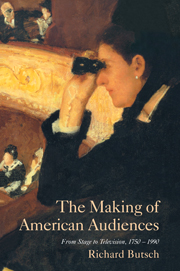Book contents
- Frontmatter
- Contents
- Acknowledgments
- Introduction: Participative Public, Passive Private?
- 1 Colonial Theater, Privileged Audiences
- 2 Drama in Early Republic Audiences
- 3 The B'Hoys in Jacksonian Theaters
- 4 Knowledge and the Decline of Audience Sovereignty
- 5 Matinee Ladies: Re-gendering Theater Audiences
- 6 Blackface, Whiteface
- 7 Variety, Liquor, and Lust
- 8 Vaudeville, Incorporated
- 9 “Legitimate” and “Illegitimate” Theater around the Turn of the Century
- 10 The Celluloid Stage: Nickelodeon Audiences
- 11 Storefronts to Theaters: Seeking the Middle Class
- 12 Voices from the Ether: Early Radio Listening
- 13 Radio Cabinets and Network Chains
- 14 Rural Radio: “We Are Seldom Lonely Anymore”
- 15 Fears and Dreams: Public Discourses about Radio
- 16 The Electronic Cyclops: Fifties Television
- 17 A TV in Every Home: Television “Effects”
- 18 Home Video: Viewer Autonomy?
- 19 Conclusion: From Effects to Resistance and Beyond
- Appendix: Availability, Affordability, Admission Price
- Notes
- Selected Bibliography
- Index
- Plate section
18 - Home Video: Viewer Autonomy?
Published online by Cambridge University Press: 05 June 2012
- Frontmatter
- Contents
- Acknowledgments
- Introduction: Participative Public, Passive Private?
- 1 Colonial Theater, Privileged Audiences
- 2 Drama in Early Republic Audiences
- 3 The B'Hoys in Jacksonian Theaters
- 4 Knowledge and the Decline of Audience Sovereignty
- 5 Matinee Ladies: Re-gendering Theater Audiences
- 6 Blackface, Whiteface
- 7 Variety, Liquor, and Lust
- 8 Vaudeville, Incorporated
- 9 “Legitimate” and “Illegitimate” Theater around the Turn of the Century
- 10 The Celluloid Stage: Nickelodeon Audiences
- 11 Storefronts to Theaters: Seeking the Middle Class
- 12 Voices from the Ether: Early Radio Listening
- 13 Radio Cabinets and Network Chains
- 14 Rural Radio: “We Are Seldom Lonely Anymore”
- 15 Fears and Dreams: Public Discourses about Radio
- 16 The Electronic Cyclops: Fifties Television
- 17 A TV in Every Home: Television “Effects”
- 18 Home Video: Viewer Autonomy?
- 19 Conclusion: From Effects to Resistance and Beyond
- Appendix: Availability, Affordability, Admission Price
- Notes
- Selected Bibliography
- Index
- Plate section
Summary
For three decades cultural critics railed at television and researchers attempted to demonstrate precisely what were the social, psychological, and political consequences of watching. Television was so alarming perhaps because it loomed so large in American life. From the 1950s through the 1970s the three commercial networks, ABC, CBS, and NBC, had commanded control of television through their 90 percent share of the nighttime audience. The average primetime show could guarantee entry for advertisers any night into nearly 30 percent of all American households. Primetime network programs had become the most widely shared cultural experience among Americans. It was taken for granted in most American families that they would watch television after dinner, separately or together – a national domestic ritual of tens of millions. For the vast majority, their choices of what to watch were limited to little more than the three major networks or reruns from those networks on independent stations not affiliated with any network.
The ritual began to unravel during the 1980s, however, as cable television multiplied the numbers of channels delivered to homes and videocassette recorders (VCRs) introduced time-shifting, commercial-zapping, and movie rental. The number of independent stations not affiliated with a network also increased, adding even more channels from which viewers could select. Remote control devices (RCDs) became desirable in this TV environment of proliferating channels and soon became standard equipment with new TVs, VCRs, and cable hookups.
- Type
- Chapter
- Information
- The Making of American AudiencesFrom Stage to Television, 1750–1990, pp. 267 - 279Publisher: Cambridge University PressPrint publication year: 2000



